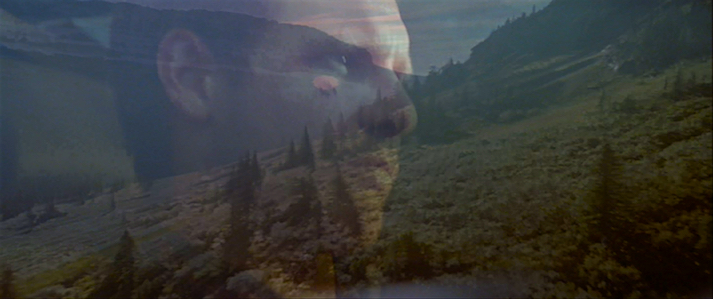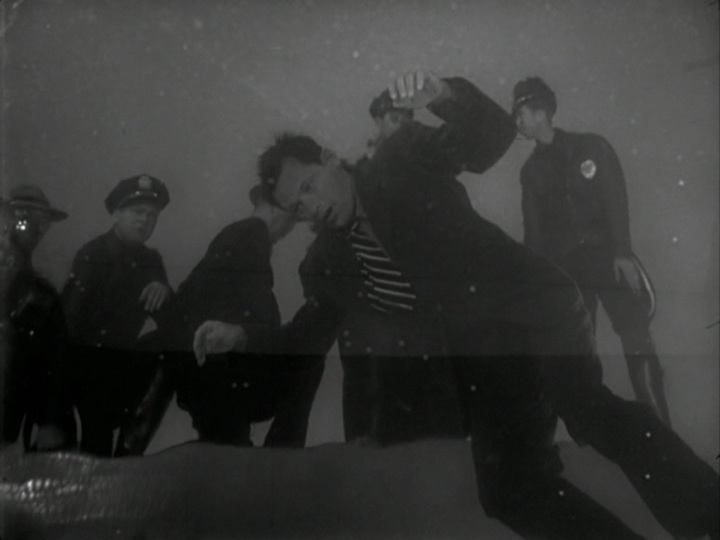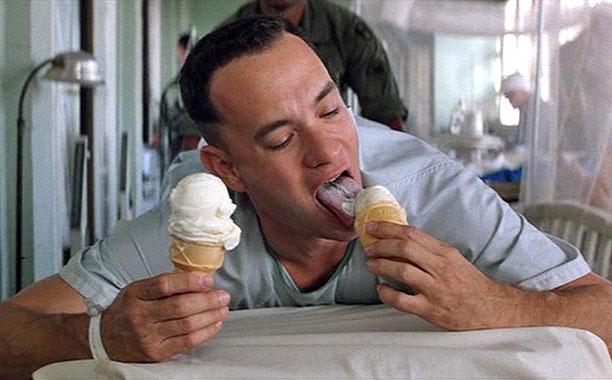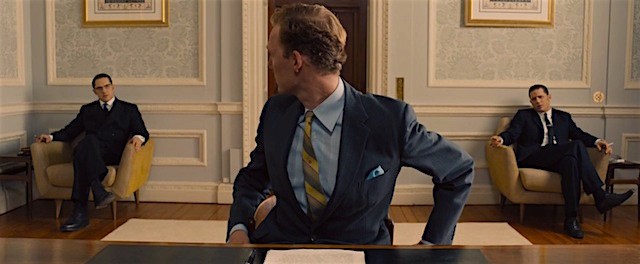
In 1982 Tangelos’ synthesized music, narrator and ill-fitting ending attempt to tell the audience to feel happy as a seminal film classic comes to its original ending.
Blade Runner
Ridley Scott, 1982
Cinematography | Jordan Cronenweth
A person has just lost their life partner and sits in a crowded room. A concerned friend approaches and sits next to the grieving individual. The friend awkward touches the friend on the arm.
“I’m so sorry. I know just how you feel.”
The friend should have stopped at “sorry.”
The absolute worst comment that can be made to a person who has just suffered a life-changing loss is “I know how you feel.” We might think we know, but the truth is we only have an empathetic idea of what another feels at such a time. It may sound trite, but human beings are like snowflakes. We are each slightly different in comparison to each other. A person has clue regarding the feelings of another human being who has just suffered a tragic loss.

The Narrator is unreliable, but Bob offers comfort.
Edward Norton & Meat Loaf
Fight Club
David Fincher, 1999
Cinematography | Jeff Cronenweth
A driver sits in her/his car at a red light. The light turns green. The driver is in a hurry, he/she applies a bit more pressure to the gas peddle than normal. Her/his car slams into the back bumper of another car traveling the intersection. The driver of the car crossing the interaction is furious. Both of these drivers will normally have opposing views of this fender-bender. In fact it is quite probable that the other drivers and pedestrians who witness the accident will have differing views regarding who is at fault.
An aging parent espouses
Perception is a tricky thing when evaluated between two or more other people. Hardly any one wants to be told how to feel. Very few like to be told what to do. But absolutely no one wants to be made to feel like an idiot.

“I feel the words building inside me, I can’t stop them, or tell you why I say them, but as I reach the top of the bridge these words come to me in a whisper. I say these words as a prayer, as regret, as praise, I say: ‘Lowenstein, Lowenstein.'”
Despite the dewy-glow of a silly subplot, the movie actually works save for a painful narration.
Nick Nolte, Barbra Streisand and nails
The Prince of Tides
Barbra Streisand, 1991
Cinematography | Stephen Goldblatt
I began with reality examples to point out that the use of voice-over narration is most often a major mistake. Not all the time, but most of the time when I see a film utilizing voice-over narration my eyes want to roll up into my head. This is a knee-jerk response that I hold at bay to give any such film in question a chance to prove the use a wise one. Most of the time when a film features a narration it comes across as lazy filmmaking. The other problem is that this style of cinematic story telling has been over used for decades. It often feels less “old-school” and more simply “old” and completely outmoded.
But there are filmmakers who can use voice-over narration to benefit their films. A solid example of a good narration use — maybe even one of the best — is Woody Allen’s Annie Hall and Manhattan. In Annie Hall Allen not only provides narration — he breaks the fourth wall. And it works! He is far from being the only film artist to successfully break that wall between the film and the audience. When Mary Harron and Guinevere Turner adapted Bret Easton Ellis notorious novel, American Psycho, for the big screen they took a major gamble for a lower budgeted independent film: They had Christian Bale’s Patrick Bateman constantly breaking the fourth wall and act as not only a narrative device but an unreliable and darkly funny one.

“I gain no deeper knowledge of myself. No new knowledge can be extracted from my telling. This confession has meant nothing.”
Christian Bale not only serves as a narrative device which breaks the fourth wall, he brings unreliable narration to a whole new level.
Christian Bale
American Psycho
Mary Harron, 2000
Cinematography | Andrzej Sekula
Wes Anderson’s The Royal Tenenbaums smartly employees Alex Baldwin to provide a voice-over narration that not only serves the film — it totally enhances the film itself. But perhaps the three best examples of voice-over narration that not only works but makes their films even better are Sunset Blvd., Taxi Driver and A Clockwork Orange. Billy Wilder was way ahead of his time when he had a dead character narrate the sad, twisted, tragic and darkly comical tale of Norma Desmond in a sure-footed feat of detailed flashback. Wilder does not rob his film of suspense by revealing that William Holden’s Joe Gillis has been killed. The use of this device adds multiple perspectives to a surprisingly blunt slap at the film industry and the notion of aging celebrity.

“The poor dope. He always wanted a pool.”
Unique twist of narration assists a movie that a cinematic game-changer.
William Holden is your dead narrator.
Sunset Blvd.
Billy Wilder, 1950
Cinematography | John F. Seitz
Martin Scorsese is a filmmaker who has always understood how to employee voice-over narration to work in his film’s favor. Robert De Niro’s Travis Bickle‘s narration not only truly drives Taxi Driver forward, it offers the viewer insights into the horrifying motivations of the title character. The film rattled cages 40 years ago and continues to do so today because we are allowed to see inside the mind of a psychopath who is humanized in our minds. His anguish and anger accelerates to a crescendo of violence that luckily resolves a horrific problem. Scorsese does not let the audience off so easily. We certainly are unable to trust Travis anymore than we can buy into his insights. The film ends with a scene that may or may not have happened, but one thing is for certain — Travis has not changed. The jarring final editing and perspectives of the closing scene leaves the audience startled.

“Listen, you fuckers, you screwheads. Here is a man who would not take it anymore. A man who stood up against the scum, the cunts, the dogs, the filth, the shit. Here is a man who stood up.”
A chilling voice-over narration that lingers forever…
Robert De Niro
Taxi Driver
Martin Scorsese, 1976
Cinematography | Michael Chapman
My personal favorite voice-over can be found in Stanley Kubrick’s amazing adaptation of Anthony Burgess’ novel, A Clockwork Orange. Meticulously designed and filmed, this iconic and controversial movie opens with an unforgettable shot. We appear to be entering an unknown world but are greeted by Malcolm Mcdowell’s unmistakable voice. It is his Alex who introduces us to Kubrick’s setting in which we find ourselves:
“There was me, that is Alex, and my three droogs, that is Pete, Georgie and Dim and we sat in the Korova milkbar trying to make up our rassoodocks what to do with the evening. The Korova Milk Bar sold milkplus, milk plus vellocet or synthemesc or drencrom which is what we were drinking. This would sharpen you up and make you ready for a bit of the old ultra-violence. Our pockets were full of money so there was no need on that score, but, as they say, money isn’t everything.”

“Giddy well, little brother. viddy well.”
A Clockwork Orange
Stanley Kubrick, 1971
Cinematography | John Alcott
And with that we are introduced into some future state of what must be England. And judging from Alex‘s Northern Lad Accent, our narrator is somewhere in the limited world of what we have come to know as council estate life. The use of this rebellious teenaged troublemaker as our narrator not only fits the film — it serves to offer us a voice to the illogical and shocking actions of our criminally insane protagonist. This mixed with Kubrick and John Alcotts’ camera perspectives delivers a disturbing evaluation of an attempt to control human cruelty by a brutality that might be even more horrid than our narrator’s psyche. Kubrick asks more questions than he answers and all he really needs is the voice-over of the film’s protagonist to deliver the gut-punches.
Francis Ford Coppola and Michael Herr had an exhausted Martin Sheen read a voice-over for Apocalypse Now as an attempt to provide structure to an epic film that wanted to spiral out of control. Some will argue that it was valid, I am not among them. This oddly effective mess of a movie is not nearly as interesting as the complexities involved in the making of it.

“Never get out of the boat.” A rather bored and sleepy narration attempts to assign meaning to the meaningless…
Martin Sheen
Apocalypse Now
Francis Ford Coppola, 1979
Cinematography | Vittorio Storaro
It has always seemed to me that Apocalypse Now would have been better served in under two hours. Marlon Brando’s rambling mixing with the horrifying ritual of animal slaughter would have helped to deliver a more satisfying film than the one (or ones) we have received. Despite itself, this is a film that cannot be dismissed.
Much like the use of sentimental orchestrated strings cue the audience that it is time to allow tears to well up or gather goosebumps as we watch the boy get the girl or the girl lose the boy — voice-over narration is usually an exercise in manipulation that most films really do not need. One of the most shameless uses of voice-over narration would have to be Robert Zemeckis’ Forrest Gump. When this movie first came out I remember thinking that there was something wrong with me. So many people seemed to love a seemingly retarded Tom Hanks intermingling with iconic events with the offer of vomit inducing non-witicisms as narration just left me annoyed. As it soon turned out — I was not alone.

“Life was like a box of chocolates. You never know what you’re gonna get.”
Tom Hanks
Forrest Gump
Robert Zemeckis, 1994
Cinematography | Don Burgess
Even when an argument can be made in favor of the poorest voice-over narrations, a counter-argument nearly always defeats it. To roll back to the beginning of this post, when Barbra Streisand decided to star and film The Prince of Tides a viewer pretty much knew what to expect. However what she delivered was a bit more and also a bit less than anticipated. Streisand was able to secure Conroy to adapt his own novel with the assistance of Becky Johnston, but a film belongs to its director. The most problematic aspect of Conroy’s novel is the romantic situation that develops between the protagonist and his sister’s shrink. This challenge found in Conroy’s novel could have easily been pushed aside for what is really at the core of the novel’s beauty. Instead Streisand pushes adultery and reckless ethics to center stage without ever noting either issue of the soft-focused love affair. What is interesting is that this is not the film’s main issue.

“I don’t know when my parents began their war against each other – but I do know the only prisoners they took were their children.”
Despite the cheesy narration Kate Nelligan delivers an amazing turn.
The Prince of Tides
Barbra Streisand, 1991
Cinematography | Stephen Goldblatt
It is Streisand’s use of Nick Nolte’s voice-over narration that most harms The Prince of Tides. This is important to note. While we all might roll our eyes at the director’s need to center herself as both the protagonist’s object of Savior and Sexual Goddess, it is harder to blame her for wanting to lose the beauty of Pat Conroy’s writing. However it is crucial for a filmmaker to remember that The Book and The Movie it inspires are two very different animals. Pat Conroy’s writing often approached poetry, but to have even the most gifted actor read it as a narrative device will usually reduce it to mush. As we see three young children holding their breath under the water and race to the top to reveal the film’s title card is cinematic. But to have that scene accompanied by Nick Nolte narrating:
“We found a silent soothing world where there was no pain. A world without mothers or fathers. We would make a circle bound by flesh and blood and water and only when we felt our lungs betray us would we rise towards the light.” It should work and for some it might, but for most of us these poetic remarks are borderline cringe-inducing. Cinema is already a language in and of itself. Narration like this is heavy-handed at best.

“It seems every day ends with a miracle here.”
Kevin Costner chose to provide the narrative voice-over for his 1990 epic.
Dances With Wolves
Kevin Costner, 1990
Cinematography | Dean Semler
If you notice a stronger opinion against Streisand’s The Prince of Tides than Kevin Costner’s Dances With Wolves, the only reason is sexism. Like Streisand’s film that would come a year later, Kevin Costner’s directorial effort was equally invested with genuine importance. Michael Blake’s book inspired Costner to make a film that offers insight into the atrocities against Native Americans. The core message does survive within the once acclaimed film, but mostly this is a vanity project in which the director casts himself in the role of object.
Consistently back lit and in soft-focus, we even get to see Mr. Costner run about nude. And even with Mr. Blake writing the screenplay, Costner leans heavy into his character’s love for an oddly 1980’s coiffed Mary McDonnell. Even the dirt on her face seems to have been placed there by Max Factor. The two white characters become pretty much take center stage bathed in light and breezy soft-focus. However barely anyone noted this at the time. Unlike Streisand, he is a man and has the auto-right to showcase himself exactly the way he chooses. But it is when Costner recites the narration that the film really rides off the rails. While the film wants to shed light on the indignities suffered by Native Americans and demonstrate the beauty that the white men destroyed, it is up to the whitest man on the planet to save the day and take center screen.
“Nothing I have been told about these people is correct. They are not thieves or beggars. They are not the bogeymen they are made out to be. On the contrary, they are polite guests and I enjoy their humor.”
Part of the problem with the narration of Dances With Wolves is its earnest self-importance, but the underlying issue is the fact that Costner sounds like a weed-lovin’ surfer about to take a nap every time he speaks. Of course it does match his flawless hair and ill-suited swagger for the era in which the story takes place.
Luckily Bob Fosse didn’t lose his focus while shooting Cabaret or we might have a film musical featuring Michael York reading from Christopher Isherwood’s The Berlin Stories! And, yes, that would have been awful.

“A paranoid schizophrenic walks into a bar…”
A brilliant actor goes for broke but a voice-over narration just about wrecks the whole thing.
Tom Hardy & Tom Hardy
Legend
Brian Helgeland, 2015
Cinematography | Dick Pope
Last year it was rumored that Brian Helgeland had finally directed a film that would match if not exceed his artistry as the writer of 1997’s LA Confidential. Having penned the script himself from John Pearson’s book about the strange and horrific story of England’s infamous Kray Brothers with Tom Hardy cast to play both brothers — the rumor seemed like it might just be a safe bet. However my gamble of seeing Legend failed to fully reward the promise of the bet.

Uh, oh. Double trouble! Better give ’em some voice-over narration!
Tom Hardy + Tom Hardy
Brian Helgeland, 2015
Cinematography | Dick Pope
It is my opinion that Tom Hardy is one of if not the most important movie actor of his generation. The guy has it all. Blessed with talent, skill, on-screen presence, charisma and rugged incredible good looks — Tom Hardy is poised to become a screen legend himself.
As both Reggie and Ronald Kray he is clearly having fun. Equally invested in both characters, Hardy plunges into the two very different but complicated psyches. Walking a sort of tightrope, Hardy manages to be touching, scary and always without fail funny as hell. Shot crisply but relying a bit too much on the limited budget to create the actor on both sides of the screen, the special effects are not always on spot.

Even though the budget has severely restricted the digital effects — These 3 are poised to creep you out and make you laugh…
Tom Hardy, Christopher Eccleston & Tom Hardy
Legend
Brian Helgeland, 2015
Cinematography | Dick Pope
Christopher Eccleston approaches his role as the copper out to stop the two brothers as if he was speeding on cocaine. Mr. Eccleston is in over-drive and manages to make a predictable cliche of a character memorable. But this is Tom Hardy’s show and it would seem to be aiming for intentional darkly twisted comedy.
Or were my laughs intended by Mr. Helgeland? Sadly if they were, he must have had a change-of-heart in post-production.
Emily Browning is not the greatest actor working, but she is certainly a capable performer. It is poor Ms. Browning who has been assigned the task of providing Legend ‘s voice-over narration.
And, this narration is bad. Painfully bad. And to make it all the worse she has been cast as the fiancée who committed suicide prior to marrying Reggie Kray. Yes, this is a voice-over narration from the grave minus any snarky sense of humor. Helgeland appears to have pushed Browning for a deadly serious reading.
And it just about strangles his film of any life. To make it all the worse, Frances Shea ‘s commentary from the dead fails to actually connect with her living character. Frances certainly displays issues regarding her intended’s way of making a living but she seems game enough to look the other way. If anything, Frances seems a bit dim-witted or simplistic in her thinking and displays none of her dead self’s anger and intelligence.

“I’m a giver. Not a receiver. I am not a faggot!”
Tom Hardy as The Kray Brothers Legend
Brian Helgeland, 2015
Cinematography | Dick Pope
But what is truly baffling about Helgeland’s use of voice-over narration is that the film needs none at all.
If a sound editor were to wipe away Browning’s narration — the film would still flow. In fact, it would flow better.
If only a few of Ms. Browning’s scenes were cut, the film would have succeeded as a demented comic take at something that really happened under the noses of England’s leadership and celebrity brass.
Legend most likely could never be a perfect film, but it could have been perfectly entertaining. As it is now, Legend nearly crumbles under the weight of a dead girl’s lofty narration.

Intentional or not, this film is often criminally comic.
Tom Hardy x 2
Brian Helgeland, 2015
Cinematography | Dick Pope
Sometimes the less said, the better.
Matty Stanfield, 3.8.16
